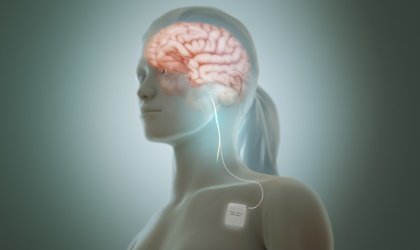Recent studies are showing that vagus nerve stimulation reduces the symptoms of resistant depression. The improvement is significant among patients who do not respond to conventional treatments. Where psychotherapy and drugs are not effective, this technique based on electrical stimulation is changing the lives of these patients.
For those who are following the progress of the world of psychology and psychiatry, they will undoubtedly know that new times are coming. Voices like those of Jim Van Os, psychiatrist and editor of the well-known scientific journal Plos One, point out something important. Treating a mental disorder is more than just focusing on the symptoms.
So far, we have focused excessively on the use of labels and terminology that is almost blindly dictated to us by the DSM-V ( Diagnostic and Statistical Manual of Mental Disorders ). However, a person is much more than a diagnosis; they are infinitely more than bipolar disorder or schizophrenia .
Authors, such as Van Os himself, propose, above all, personalizing treatments. Something like this is undoubtedly essential for those who, for example, suffer from major depression and have not found any strategy that provides them with any improvement. In these situations, it is necessary to explore more options, where the expert professional and the patient can find the answer that best suits their particularities.
In recent years, they have already developed an innovative strategy: vagus nerve stimulation.
The vagus nerve is one of the most important cranial nerves. It is cranial nerve number X and is, at the same time, the most predominant neural effector of the parasympathetic nervous system.
The relationship between vagus nerve stimulation and resistant depression
The vagus nerve is one of the most important cranial nerves. It is the longest and is distributed below the level of the head and is part of the parasympathetic nervous system. Furthermore, if there is one thing that distinguishes this neural structure, it is its multiple functions, including sending and receiving information from practically all of our organs.
Its main task is therefore to regulate and know the state of this sensory universe of our organism. It regulates the heartbeat, controls the proper functioning of digestion, and induces relaxation after physical effort. We could say that it is that supervisor, exceptional for its value, who is always looking out for our well-being.
Until recently, experts knew about its relationship with anxiety and stress, but in 2006, a study published in the journal Biological Psychiatry demonstrated something even more interesting. Stimulation of the vagus nerve opened up a new therapeutic method for the treatment of resistant depression .
What does vagus nerve stimulation generate?
Charles Conway, a psychiatrist at the University of Washington, was clear that new strategies were needed to treat resistant depression. We often see patients who take up to 3 or 4 antidepressants a day without experiencing any improvement. So the goal was clear: to offer them quality of life.
At the University of Washington School of Medicine, they have been experimenting with this method for several years. So far, they have treated 328 patients, with very successful results.
- Vagus nerve stimulation optimizes the monoamine synapse of the brain’s neuronal circuit, which is dysregulated during depression.
- It also optimizes the function of the cerebral cortex and the amygdala, the latter structure often showing hyperactivation, which generates feelings of alarm, fear, and discouragement.
- Patients with severe and recurrent unipolar and bipolar depression have shown remarkable changes. So much so that after undergoing vagus nerve stimulation they have begun to show improvements in psychological therapy.
How is vagus nerve stimulation performed?
Vagus nerve stimulation is carried out by neuromodulation. There is therefore electrical stimulation to reactivate the function of this nerve.
For the treatment to be effective, small devices have been designed in recent years that are implanted (through outpatient surgery) under the skin of the chest, on the left side. As soon as it is activated, it begins to emit electrical signals through the vagus nerve until it reaches the brain.
The improvement in mood improves within a few days.
Important aspects of vagus nerve stimulation
Before finishing, there is one important aspect to note. Vagus nerve stimulation is not an exclusive or definitive therapeutic strategy to end the depression. It is a mechanism that improves the quality of life and, importantly, makes other treatments (such as psychological therapy) effective.
It’s like an awakening. This precise and controlled electrical stimulation makes the person feel better and makes them receptive. Suddenly, patients can concentrate again, become interested in a film, or a book, or go for a walk. The mood improves and the motivation to make changes is awakened.
This is when psychological therapy can be more effective than ever. This is the moment when the person can be provided with adequate strategies to deal with their reality. There is also another detail that we must consider. It is estimated that between 30 and 40% of people with major depression may present resistance to treatment. In those cases where we have a nearly catatonic patient, vagus nerve stimulation emerges as a highly effective strategy.
We will therefore be waiting for further developments on this topic.
All sources cited were thoroughly reviewed by our team to ensure their quality, reliability, timeliness, and validity. The bibliography of this article was considered reliable and of academic or scientific accuracy.
- Barral, JP. (2009). Vagus nerve. Manual Therapy for the Cranial Nerves. Elsevier: USA.
- Charles R. Conway, Arun Kumar, Willa Xiong, Mark Bunker, Scott T. Aaronson, and A. John Rush. “Chronic vagus nerve stimulation significantly improves quality of life in treatment-resistant major depression.” The Journal of Clinical Psychiatry DOI: 10.4088/JCP.18m12178
- Rhea, P. (2014). Vagus Nerve. Clinical Anatomy of the Cranial Nerves. Elsevier Academic Press: UK.

